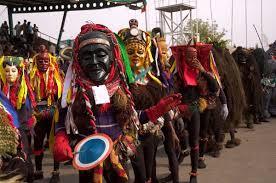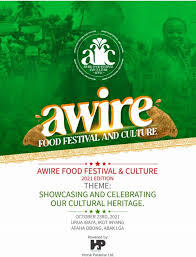By Ephraim-Stephen Essien, Ph.D
This short piece links usoro awire (water yam festival) with the ekpo masquerade festival in Anaañ society, highlighting their significances.
Usoro Awire (Water yam festival)
Usoro Awire (Water yam festival) describes an annual event in Afaha Obong (the cultural headquarters of Anaañland) when the people of Afaha Obong and the wider Anaañland assemble at the Ibaiya market (urua Ibaiya) in Ikot Inyang village to showcase their water yam produce, reunite with their kindred amidst dances and fanfare, to honour the living-dead, and to give thanks to Awasi Ibom (the supreme being) for their bounteous harvests.
The water yam festival ushers in the last phase of the ekpo season called ndok ekpo. It is believed that, soon after the water yam festival celebration, the remains of the yam, called nkai, are left for the ancestors or living-dead to eat; and, since the ekpo masquerades represent the ancestors, these last few days in the month of October are left for their veneration and honour. These few days are associated with restriction of movements by women and non-initiates.
Related post
- Marking Awire Food Cultural Festival In Akwa Ibom Community
- Stop Libation, ban harmful Cultural Display- Udoma urges
These practices are still observed unto the present day in Afaha Obong and in Anaañ in general, and it is taking place today, 23rd October, 2024, at the Ibaiya market, Ikot Inyang village in Afaha Obong, Abak local government area of Akwa Ibom State, southern Nigeria. The significance of usoro awire is the revitalization of their sense of community (mmana-mo) and the honour to the living-dead, the ancestors.
Ekpo Masquerades in Anaañ Culture
The term ekpo means spirit. It also means ghost. Ekpo masquerades symbolise the dead members of the Anaañ community. The Anaañ believe in a close communion between the living and the dead. The Ekpo masquerade institution keeps the memory of the dead and their participation in the affairs of the community alive.
Types of Ekpo
The Ekpo masquerades represent all kinds of persons in the community. These are symbolized on the masks they wear and how they play out their roles when they are on parade.
- Eka Ekpo (mother masquerade) symbolized absolute power with its seven faces.
- Akpan Ekpo (first son of the masquerade) symbolized youth and beauty.
- Abaikpa Ekpo (maiden masquerade) symbolized youth and virginity.
- Afai Ekpo (wild masquerade) was a symbol of insanity and madness.
- Imum Ekpo (the dumb masquerade) otherwise called Udoudo Udom Umoh (in Afaha Obong) was a symbol of the voiceless in the society.
- Ete Ekpo/Atitia Ekpo (the father masquerade and teacher masquerade) symbolized the elders who instructed other members of the community.
- Ajara ikpa (the leather wearer) was a symbol of the gorgeous in the community.
- Inyion Ekpo (the crippled masquerade) was a symbol of suffering in the society, and it was always limping when on parade.
The masquerades always carry the matchete (ikwa) or sword (akangkang) and the bow (utia) and arrows (irang). The mother masquerade (Eka Ekpo) had the sole privilege of carrying seven spears (eruad itiaba), while Akpan Ekpo could carry only one spear. Afai Ekpo carries the sword (akankang).
Ekpo parade and Ekpo song
Before their public outing and parade, the masquerades were always preceded by the herald or attendant (akwa ekpo), who would run out and run back rhythmically, shaking his rattle (ekpood) and chanting songs along his way. The wild masquerade (afai ekpo) and the crippled masquerade (inyion ekpo) were instructed not to shoot their arrows in the market place. Hence the song:
“inyion ekpo ku utop irang ku urua o!”
(“crippled masquerade, don’t shoot your arrows in the market o!”), and this would be followed by some drumming, “kwok, kwo-kwok, kwok!”
Ekpo masquerade season in Afaha Obong
In Afaha Obong in Abak Local Government Area of Nigeria’s Akwa Ibom State, the Ekpo masquerade season festival was often heralded by the public entry into the Ibaiya market by Nwa Ibaiya (literally, second daughter of Ibaiya), a certain kind of Ekpo masquerade. Thereafter, each village would have their Ekpo parades and outings. The parade would start from the Ekpo square (Anwa Ekpo), through the main pathways/roads through the villages, heralded by Akwa Ekpo, but led by Akpan Ekpo.
All the kinds of Ekpo would be on display with their various masks, some of which were artistically carved in wild animals’ symbolisms, such as symbols of snakes, eagles, lions, etc. The masks on their faces were held on by mkpatad (a species of green ferns) on their heads. The parade was very orderly as the masquerades walked in single files along the way, followed by the villagers amidst loud acclamations of joy and awe, excitement and panic.
However, three kinds of masquerades were too fearsome to follow. These were Eka Ekpo, Inyion Ekpo and Afai Ekpo, because they were not friendly as others on parade. Other masquerades even had to run away when the Eka Ekpo would come out with her seven spears. It was usually the last to come out. Eka Ekpo instilled fear and awe on its way.
The Ekpo parade usually ended at the market, depending on which market was open for that day.
Nkakad/Nsiwidi
The Ekpo masquerades did not speak intelligibly to the understanding of their admirers, but would make loud cries which sounded like “Uwa O! Uwa O! Uwa Oh…!” Members of the Ekpo society had a secret code of writing or script called Nkakad, similar to the Nsiwidi (Nsibidi) of the Ekpe society in Efik culture. This script could only be understood by members. Members of the Ekpo society were always initiated into the society.
Among the male youths, non-members of the Ekpo society could be identifiable by one’s inability to invoke the Ekpo pledge:
Ekpo nyoo! Nyo!
Ekpo Nyoo! Nyo!
Nnyonyo Ekpo, Aban adia
Ubanna ban, Asong Akpoho
Ijommo Akpo: Ooo!
The months of September and October were the months for celebrating the Ekpo masquerade festival. Non-initiates, mostly women and some youths, were not free to move around the community at the climax of the festival, called ndok ekpo, usually the last week of the month of October.
Ekpo Ntok Ajen (literally Children Masquerade)
Apart from the big-man masquerades, there is also the Ekpo Ntok Ajen or Akpan Ntok Ekpo (literally children masquerade), which symbolizes procreation. The months of November to the eve of Christmas was set aside for celebrating this category of Ekpo masquerade. The Ekpo ntok ajen were not permitted to carry the bow and arrow, but they could go with canes. Their masks are not not as scary as the masks of the big-man masquerades. They are as beautiful as the youths.
The Ekpo ntok ajen also has its anthem, which runs as follows:
Ekpo ntok ajen akwa agwo ekpo de!
Ama aru unogho inung, afo anno ntuen de!
Ntuen akede akwa ujod ekpo!
Ntuen akede akwa ujod ekpo!
Chorus
Ama unogho inung, afo anno ntuen!
Ama unogho inung, afo anno ntuen!
Ntuen akede akwa ujod ekpo!
Ntuen akede akwa ujod ekpo!
Ntuen akede akwa ujod ekpo!
Ntuen akede akwa ujod ekpo ooooo!
Uwa O!

The Ekpo masquerade institution was originally used as law enforcement agency in Anaañ society. Ekpo masquerades in Anaañ culture must be understood within the context of Anaañ belief system and her notion of reality. Within this belief system is the auxiliary belief in the physical and the spiritual planes of existence, the belief in the ancestors and the belief in aruru (force). It is within this worldview that the ekpo masquerades are believed to be the ghosts of the living-dead in the Anaañ community.
Ephraim-Stephen Essien, Ph.D ([email protected])

